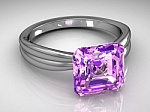History of Diamond Investing
Everyone knows the saying that Diamonds are a girl’s best friend however if you’ve bought diamonds at retail and tried to resell them than diamonds have not been your bank account’s best friend and not even on speaking terms with your investment portfolio. Traditionally speaking while Diamonds have often been thought of as a go to currency that could provide some level of back up in an emergency situation the idea of diamonds as a part of a stable investment portfolio was just out of the question due to the DeBeers company’s undue influence on the price point of diamonds.
That all changed in the early 2000’s when large stores of diamonds were found in various parts of the world that didn’t want to come under the thumb of the DeBeers group of companies. Suddenly the diamond market was free to flow as an international commodity with the free and open market determining the price points just as gold, silver, and other precious metals have been flowing for centuries.

Domestically, the movement toward diamonds as pure investment vehicles solidified on August 7, 2012 when the United States Patent and Trademark Office granted a patent on a process that classifies Investment Grade Diamonds for financial investment and commercial trading. This certification process sets a standard which now allows diamonds to be a publicly traded asset class that can be traded on US Securities markets. So now that diamonds are officially able to be traded, as a financial vehicle the question becomes which diamonds have the chance to be your portfolio’s best friend and which ones are best used an ornament? Here are six diamonds that make the grade as quality investment vehicles.
The Type of Diamond That is good to Buy
As in any other market the value of an item is simply determined by the price that someone willing to pay for that item. It is basic supply and demand 101. The laws of supply and demand haven’t been suspended for diamonds so the more rare the diamond the higher the value. Over the last few years fancy colored diamonds, particularly Yellow, Pink, Blue, and Green diamonds have shown to be fairly stable investment vehicles due to their rare nature. The key here is that a fancy colored diamond is not easy to find so the price is higher than anything else.
If you’re not in the market for colored diamonds then the next best investment grade diamond is a clear or colorless diamond. Colorless diamonds are premium because they allow for the greatest reflection of light and, therefore, emit the most dramatic sparkle.
A secondary factor in diamond grading is the clarity of diamonds, the more clarity the higher the quality. The highest grade is an F for flawless if you are looking for a diamond that is going to hold it’s own in the market then one without flaws is the way to go.
The final factor in determining the investment grade of a diamond is found in the cut. Early in the twentieth century the optimal proportion of cut was mathematically determined in order to bring maximize the stone’s brilliance. Essentially speaking the closer the diamond is to matching that perfect cutting formula the better. For this reason a smaller well cut diamond has more value than a larger poorly cut diamond. If you’re looking for a diamond to slip on someone’s finger and want to impress the person with size you can get away with an larger off perfect stone however if you’re looking for a quality investment item you’ll want to make sure that the rock you are investing in is as close to mathematically perfect as possible.
Blogger Galert Alice, one the author at Diamondstoresreviews.com enjoys writing for Bluenile store reviews. Click here to learn more!

